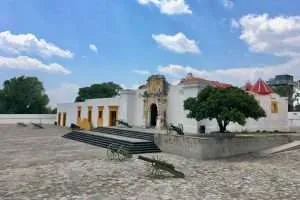
Marvel at the splendor of its elegant colonial buildings, streets and flavors that live up to its nickname "City Of the Angels".
A legend is responsible for this beautiful city being known as Puebla de los Angeles.

The Chapel of the Rosary is the chapel attached to the Temple of Santo Domingo in the city of Puebla. Work of the XVII century, summit of the novohispanic baroque, it was qualified in its time as The House of Gold, as well as the eighth wonder of the world by Fray Diego de Gorozpe, in a print of 1690.
It is the most outstanding example of the Novo-Hispanic baroque and one of the greatest artistic and religious achievements in Mexico.
The interior of the chapel is majestic, where the architectural structures have been covered in every corner with reliefs in golden stucco, in order to exalt the religious feeling.
In the upper part of the walls of the chapel there are six large canvases by the painter José Rodríguez Carnero, with themes alluding to the Gozos de la Virgen, while in the lower part the walls show a beautiful tile lambrin of the talavera type.
In the transept there are other paintings with themes also related to the life of the Virgin, as well as another large painting that crowns the apse of the chapel and is dedicated to the Glorification and Triumph of the Rosary.
The golden charm that envelops the visitor in this place earned the space the title of "reliquary of America" by H.H. John Paul II, who, during his first visit to the country in 1979, had the opportunity to admire it and fall in awe of its beauty.
—
After the Temple of Santo Domingo was finished, in 1650 the Chapel of the Rosary began to be built; this work took 40 years to finish.
This construction was made in honor of the Virgin of the Rosary, which was of great importance for the Dominicans, since they were one of the first religious orders that arrived in New Spain with the purpose of evangelizing.
This type of construction is a reflection of the economic reach of the church in those years and of the ambition and sumptuousness with which its temples were planned and erected.
The temple where it is located began to be built in 1550 and in 1650, the construction of the chapel began, which was completed in 1690.
It was consecrated on April 16 of that same year, to coincide with the date on which the City of Puebla de los Angeles was founded. There were great celebrations that lasted eight days, so it received the name of La Octava. There were processions, masses and events full of joy.
It was Fray Juan de Cuenca who had the idea of building this Chapel dedicated to the Virgin of the Rosary; however, it was finally completed by Fray Diego de Gorozpe in 1690 and inaugurated on April 16 of that same year, to coincide with the date on which the City of Puebla de los Angeles was founded, thus giving 9 days of celebration.
The side walls of the chapel are covered with large canvases painted by the painter José Rodríguez Carnero (1649-1725).
The themes that Rodríguez Camero chose were those of the Gozos de la Virgen, done in a dark light style that contrasts with other paintings full of clarity that he himself painted to decorate the transept.
The gold used to decorate this church came from Guanajuato, from a mine called La Valenciana.
It is said that the owner of the mine, Antonio de Obregón was very devoted to the virgin, because he claimed that thanks to her he had saved his life. In gratitude, he was in charge of taking the necessary gold to Puebla.
The information says that the gold came in the form of 24 carat powder. In order to be able to work this gold, 3 carats of copper powder was added to it, together it becomes solid.
The piece of gold metal that was formed was wrapped in leather and the goldsmith hand laminated that piece of metal, which was left microns thick. The glue in those years was honey, egg whites, aloe, milk, cactus slime.
Address: Av. 4 Pte., Centro histórico de Puebla, 72000 Puebla, Pue.
Sitio Web Capilla del Rosario – Link
More Official Info: Visit Puebla
Marvel at the splendor of its elegant colonial buildings, streets and flavors that live up to its nickname "City Of the Angels".
A legend is responsible for this beautiful city being known as Puebla de los Angeles.
The country is a land of contrasts. It has it all: a rich history and culture, a warm and pleasant climate, a varied geography, an impressive nature, a tasteful gastronomy and a friendly and helpful population ... in short: Mexico can fulfill all your wishes!